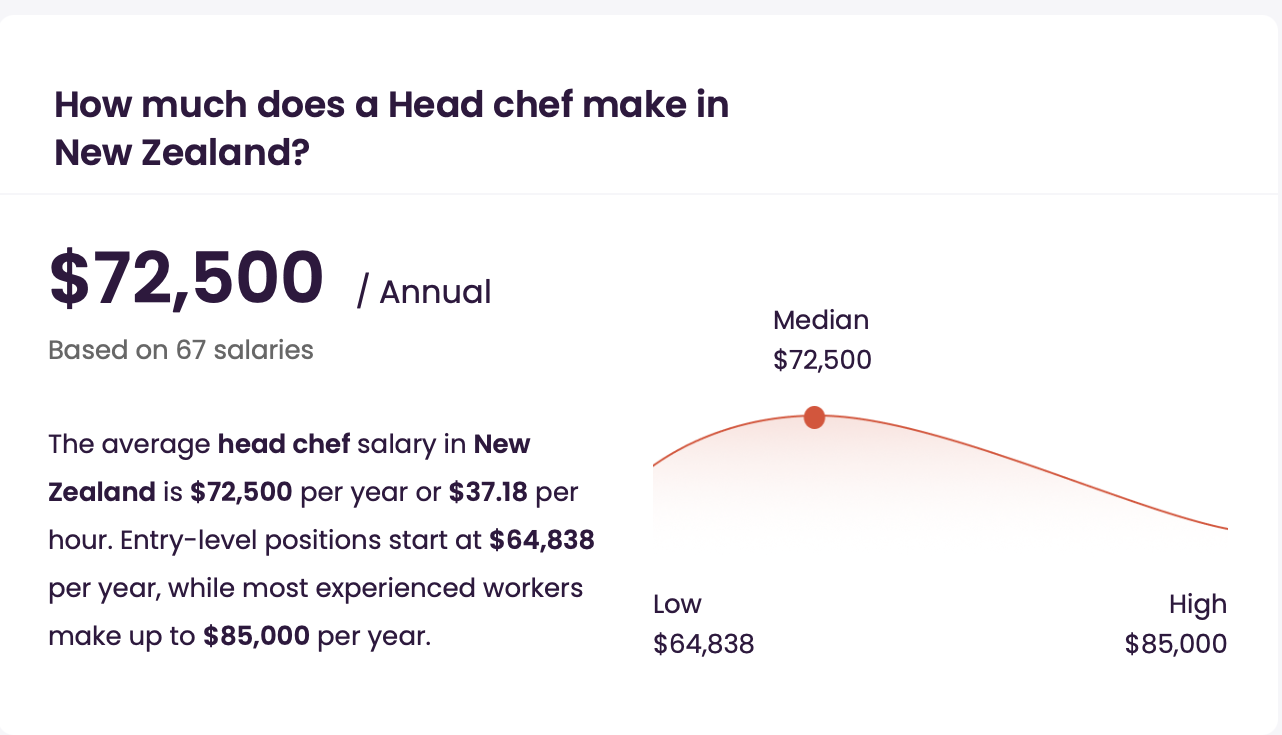What are benefits?
Cash isn’t the only way to reward employees. Non-monetary benefits or incentives can be very effective in motivating and engaging staff, especially in times of economic hardship when cash rewards are not viable. Examples of non-monetary compensation include work flexibility, gym memberships, Christmas parties… Google offers on-site haircuts to its employees.
What are some of the advantages of offering non-monetary benefits and incentives to employees?
Exercise 8
- Think of some non-monetary benefits the owner of a stand-alone restaurant could offer kitchen staff. Consider what might be appropriate for different levels of seniority (i.e. junior staff such as kitchen hand, to senior staff such as head chef). Make notes in your journal.
- Click on this link to read the article about wages of hospitality workers in NZ. Identify the main issues raised and offer some realistic solutions to overcome these.
- What is a penal rate? Which penal rates are legislated in NZ (and which are not?) How do we compare to Australia? Would penal rates make hospitality more appealing as a career?
Self-Directed Learning
The following information comes from a 2022 nz.talent.com survey. Check your answers with your tutor.

- How was the median salary calculated from the 18 salaries surveyed?
- Calculate a head chef’s (median) pay, to the nearest cent, if she is paid:
- Weekly
- Fortnightly
- Monthly
- Explain how the hourly rate $35.90 has been calculated from the annual salary figure
- On average, how many hours per week does a head chef work according to the calculation in question 3? Does this represents a typical workload for a head chef? Explain your answer.$70,000 represents gross income - before any taxes have been deducted. Net income refers to the money you take home once all taxes and contributions have been deducted.
- Find out what compulsory deductions would be made to the $70,000 salary according to NZ law, hence calculate the net annual salary of a head chef in NZ.
Checkpoint
Assessment 3.2, Task 1

What does “induction” mean?
The NZ government website employment.govt.nz defines Induction as: “the process of introducing the new employee to the organisation, their team, their job and what their employer expects of them”.
Exercise 9
- Why is the induction process so important?
- Read this web page on induction and in your journal explain, in your own words, why the induction process is so important.
- List the importance and benefits to both new employees and the employer.
On the same web page, there is a list of what an induction process MUST include, and also optional items. In your own words, summarise the main features you think should be covered in an induction for a new chef starting in a busy restaurant. Include (and differentiate between) both:
- Compulsory items.
- Optional items.
Self-Directed Learning
Watch the following video to learn a little about how the induction process should (and should not) look.
- Have you or someone you know had personal experience of an induction – good or bad? Describe this experience in your journal.
- Summarise the features of a ‘good’ induction as a bullet point list.
As we have discovered, there is a lot of information a new employee needs to learn, and the quicker this happens, the faster he or she gets up to speed and becomes a productive team member.
The information required is of different kinds, and ways to communicate and gather the information should also vary. This means using a range of methods and even people to conduct the different parts of the induction.
Exercise 10
- Four induction methods are described below:
- FACE TO FACE- communication is important to initiate personal relationships and for interactive information sharing – it is easy for an inductee to ask questions and allows the inductor to read body language and facial cues to gauge whether the inductee is responding to the information. Face-to-face reduces misunderstandings and miscommunication.
- GROUP INDUCTION is a practical and efficient way to communicate information to several people at the same time. When more than one person is starting in a workplace on the same day, group induction saves time and effort in communicating generic information. It helps to initiate teambuilding and can be done in a fun and engaging way with games, exercises etc.
- E-LEARNING. A lot of detailed information about company policies, H&S, systems and culture as well as job specific knowledge can be stored online. A big advantage of this system is that it can be done any time, from anywhere.
- A BUDDY SYSTEM involves assigning a buddy or mentor to help get a new employee settled in to a work place and up to speed. The buddy works alongside the new employee, showing them around the workplace, answering questions and offering specific and detailed information about the particular job the new employee has been hired to do. This is a great way to initiate teamwork and to get a new employee feeling comfortable and confident with their new role. A buddy should be familiar with all of the details of the role.
- Use this template and state for each:
- The type of information best communicated by this method.
- The disadvantages of using this method.
- Once you have completed the exercise, discuss with a classmate and compare lists. Report back to your tutor.
Self-Directed Learning
Read the following account from pdfslide.net, then answer the questions that follow.
First Day On The Job:
Sheila felt ready to get to work after her one day job orientation for new employees. When she got to work, however, she was shocked. She was not prepared for the fast pace, sophistication and skill level found in her new department. By noon that day, Sheila felt like she was not cut out for the job. She felt under-skilled and under-prepared to meet her department's challenges.
On her way to the company cafeteria one of her co-workers, Tammy, caught up with her and they had lunch together. Sheila was glad that Tammy was so friendly to her and she was able to relax a little bit. During lunch Tammy talked about their manager, Mr. Smith. Sheila learned that Mr. Smith was in trouble with his superiors.
Next, Tammy told her about James, the computer programmer. She told Sheila that James spread rumours and was not to be trusted. She talked about Mrs. Tyler, the accountant. She said that Mrs. Tyler was an alcoholic and frequently took sips from a whisky bottle in her desk.
Tammy asked Sheila to join her for coffee after work. She said, "Trust me, Sheila. Once you come to understand how screwed up everyone is around here, and get the feel of the place, you'll do fine."
Questions:
- Why would Tammy be so friendly towards Sheila?
- What might happen if Sheila gets close to Tammy?
- Have you ever been in a similar situation?
- How should Sheila deal with this situation moving forward?
(pdfslide.net)
Exercise 11
Think about the type of information a new employee needs to learn. How could you present the following to him/her so it is easy to understand, and interesting to learn?
- Physical information, such as location of important places in the building, where to find different people etc. Face to face – e.g. Guided tour of the building by head chef or supervisor
- Company rules and policies, and company culture e.g. health and safety, how to complete time sheets, how to apply for leave, break times etc. information
- Specific information on how to do the actual job the employee was hired to do.
Exercise 12
Scenario:
You are the head chef of a large restaurant. Sonny is starting work in your kitchen today as a commis chef. You are in charge of introducing Sonny to the new work place and need to get him up to speed and productive as quickly as possible.
- Design an overview for Sonny’s first day induction. Use items from the previous exercises to decide what Sonny needs to know on Day One, then list them below in the order you think they should be done. Briefly explain:
- WHY each item is important for Sonny to know.
- HOW the information will be communicated.
- WHO should conduct that part of the induction process.
Self-Directed Learning
Complete the Day 1 induction overview and post on the online discussion forum. Read other student’s plans. Did you miss any important items? Is there too much information for a single day?

Any process needs to be evaluated and measured to check it is ‘fit for purpose’ (i.e. doing what it was intended). The induction process is no exception.
In this section, we look at ways in which a business can check how well the induction process is working in achieving its goal.
Recap question – What are the main goals of an induction process? (Write your ideas in your journal.)
Exercise 13
- Recall the types of induction information from the previous session:
- Physical information, such as location of important places in the building, where to find different people etc.
- Company rules and policies, and company culture e.g. health and safety, how to complete time sheets, how to apply for leave, break times etc.
- Specific information on how to do the actual job the employee was hired to do.
- For each category above, design an evaluation method to gauge how effective the induction process was. (Choose a different format for each type of information.)
- Your tutor should discuss your evaluation methods with you.
Self-Directed Learning
Checkpoint
Assessment 3.2, Task 1
